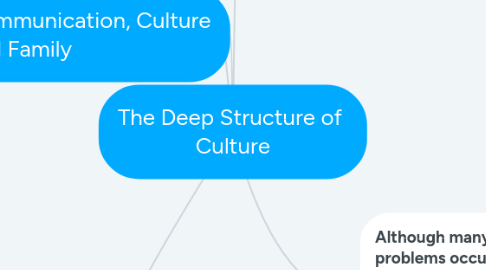
1. To this point we have not discussed specific cultural differences in child-rearing practices, particularly those that get reflected in communicative behavior. However, we are now ready to establish a link between the family and intercultural communication
2. Communication, Culture and Family
2.1. GENDER ROLES
2.1.1. One of the most important family patterns is the teaching of accepted gender roles. As Wood notes, “Families, particularly parents and stepparents, are a primary influence of gender identity.” 77 The learning of acceptable gender roles begins as soon as the announcement is made proclaiming that a newborn is a boy or a girl. Robbins observes, 72 CHAPTER 3 • The Deep Structure of Culture: Lessons from the Family “The infant is given a gender-appropriate name, dressed in properly designed or colored clothing, and spoken to in gender-appropriate language.
3. Individualism and Collectivism
3.1. importance to the study of intercultural communication are the notions of individualism and collectivism. These two orientations will occupy a large portion of Chapter 6. We want to introduce the terms now, however, for they play a significant role in childrearing practices and in the interaction that takes place within a family.
3.1.1. Individualism and the Family
3.1.1.1. For Americans, individualism, as it applies to families, is partially linked to the history of the United States. From earliest colonial times through the Industrial Revolution period, the nuclear family has been prominent in American culture. In these first nuclear families, early travelers to the CONSIDER THIS Do you think immigrant families should adapt to their host culture or hold on to the values they know and feel comfortable with? Individualism and Collectivism 79 United States would report that parents were proud of their “wildly undisciplined, self-assertive offspring.
3.1.2. Collectivism and the Family
3.1.2.1. The contrast between individualistic and collective extended families is vivid when we turn to Latino cultures. “Extended family members rely on one another to take care of children, [and]…provide friendship and support.” Ingoldsby offers a synopsis of the Latino experience within the family as a “type of social organization that places the family ahead of the individual’s interests and development. It is part of a traditional view of the society that highlights loyalty and cooperation within the family.”
4. CULTURAL VARIANTS IN FAMILY INTERACTION
4.1. the role of family in cultural interaction patterns, three disclaimers are in order. First, all of the major institutions of a culture are linked. While the concept of family as a single social organization is used, you should be aware that it works in conjunction with other aspects of a culture.
5. Although many communication problems occur on the interpersonal level, most serious confrontations and misunderstandings can be traced to cultural differences that go to the core of a culture
5.1. DEEP STRUCTURE INSTITUTIONS CARRY CULTURE’S MOST IMPORTANT MESSAGES
5.1.1. The social institutions of family, state, and religion carry the messages that matter most to people. Whether you seek material possessions to attain happiness or choose instead to seek spiritual fulfillment, the three deep structure institutions help you make major decisions regarding how to live your life.
